No team is able to hit the ground running with a project at their first meeting. Instead, they go through a complex process that involves the 5 stages of group development, including:
- Forming,
- Storming,
- Norming,
- Performing, and
- Adjourning.
In fact, your team could consist of the best talent in the world. But, this means little if they don’t have a framework for working together — and that’s where the 5 stages of group development come into play.
In this blog post, you’ll learn everything you need to know about creating a high-performing team, including:
- What group development stages are,
- How this team development model increases cohesion,
- Which illustrative examples you can use every day, and more!
Without further ado, let’s get rolling!

Table of Contents
What are the 5 stages of group development?
The stages of group development in organizational behavior and management comprise the theory of team development. In other words, it’s a group-forming model that consists of 5 distinct phases.
According to these stages of group development model, each group or team is likely to go through the following interconnected 5 phases during their joint work, including:
- The Forming Stage — characterized by team orientation,
- The Storming Stage — characterized by a power struggle,
- The Norming Stage — characterized by cooperation, integration, and unity,
- The Performing Stage — characterized by overall synergy, and
- The Adjourning Stage — characterized by a sense of closure.
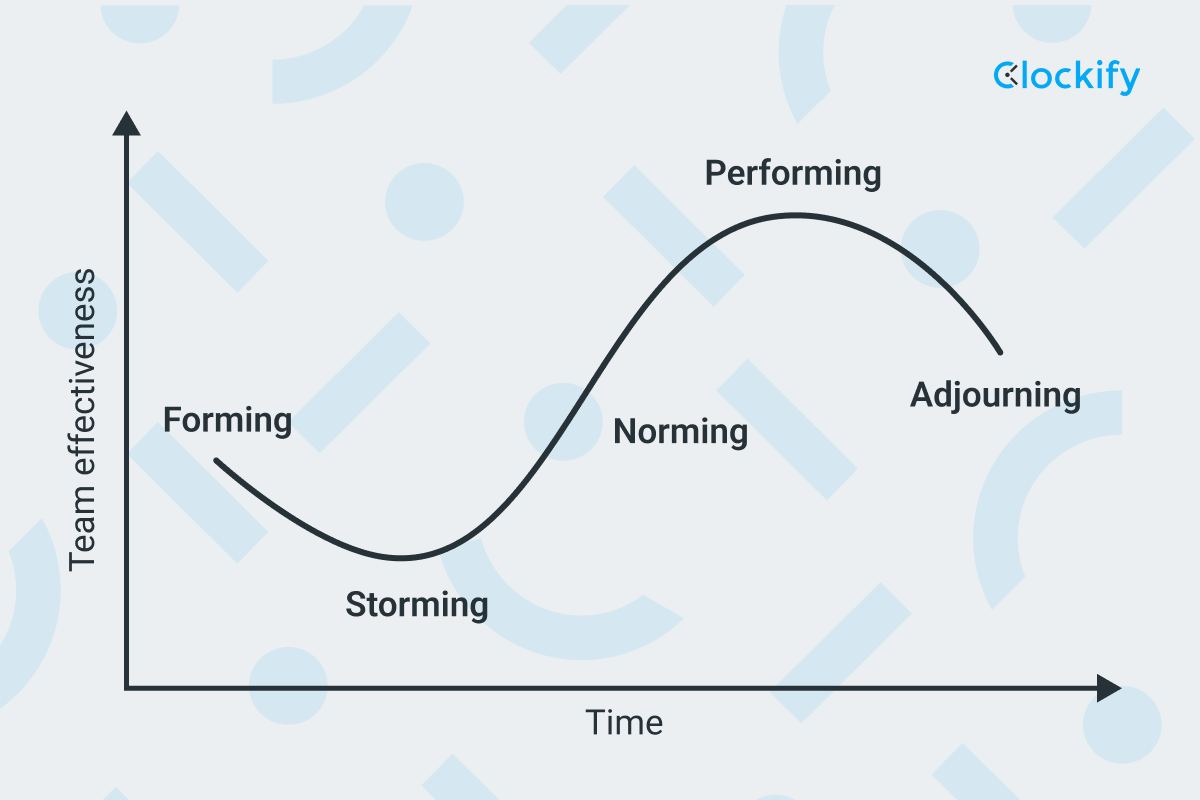
Now, these 5 stages are vital to help you anticipate your team effectiveness. Simply put, that’s your ability to be efficient and productive with your work, both as individuals and as a group.
Enhance performance with Clockify
The diagram shows that the effectiveness of a team or group fluctuates over time.
In other words, the energy levels reach their ultimate low in the Storming Stage because the struggle to find the leader and build some structure creates frustration and mood fluctuations. That’s why this stage is often called The Power Struggle Stage.
In turn, the level of effectiveness reaches its peak in the Performing Stage, when team members use well-oiled workflows and communicate feedback effectively to make the project smooth sailing. This stage is sometimes dubbed The Synergy Stage.
💡 Clockify Pro Tip
Here are 25 techniques and tips to drastically increase your productivity in a matter of days:
Who invented stages of group development?
The renowned Bruce W. Tuckman — a researcher at the American Psychological Association — established a 4-step model in 1965 in his landmark paper titled Developmental sequence in small groups.
In Tuckman’s words, the listed stages are obligatory for a team to:
- Grow and progress,
- Face challenges and problems,
- Find solutions for challenges and problems,
- Plan and tweak their individual and group workflows, and
- Reach their expected project goals.
Yet, this model was initially known as the “Forming-Storming-Norming-Performing Model.” Experts often refer to this original model as the 4 stages of group development.
In fact, Tuckman only added the fifth, Adjourning Stage, together with another expert, Mary Ann C. Jensen, in 1977. The newly crafted review paper was titled Stages of Small Group Development, Revisited — and it became what we today refer to as the Tuckman model of team development.
What industries benefit from Tuckman’s model
Anyone can harness the power of the 5 stages of group development in pretty much every scenario, including:
- Tech companies,
- University projects, and
- Home refurbishment.
Interestingly, the 5 stages of group development model can even be useful in the theater.
For example, a 2019 paper by an adjunct assistant professor at Queen’s University, Rebecca Stroud Stasel, found that some people feel a strong attachment to leadership. In fact, she argues that theater team members can “discover facets of themselves through leadership processes.”
Furthermore, Rebecca Stroud Stasel cites that people have natural, deeply seated tendencies for either leadership or following leaders.
In other words, any team setting that requires high performance can benefit from using this model.
As a result, we can conclude that the Tuckman model spans culture, politics, and any other social sphere of our lives.
The stages of group development with examples, explained
By implementing the 5 stages of group development, teams can reap vast benefits due to the clear-cut structure and step-by-step approach.
In fact, each phase plays a critical role in the team’s progress — whether in short, medium, or long-term goals. That’s where Tuckman’s stages of group development yield immense results.
Here, I’ll provide plenty of helpful examples for each of the 5 stages of group development, including:
- Forming,
- Storming,
- Norming,
- Performing, and
- Adjourning.
Let’s get going with the Forming stage.
Stage #1 — The Forming Stage
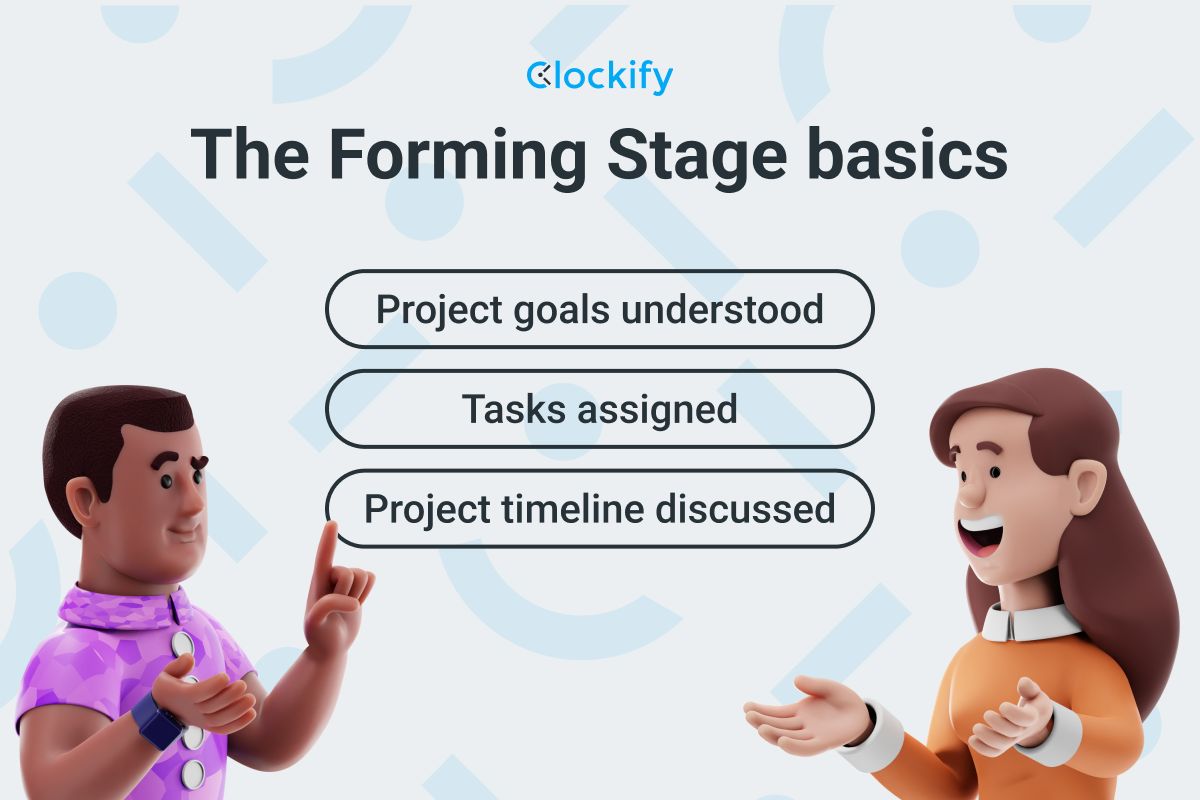
The Forming Stage is about team orientation.
Everyone is just getting to know one another. Likewise, they are overly polite to each other because they are looking to be accepted among this new group of people.
For the same reasons, they may also be a bit uncertain and anxious.
They are also overly positive about the project because it’s new — and new is always exciting.
At this initial stage, a glimpse of a future project leader may emerge. For illustration, the person with the largest knowledge about the project’s subject takes unofficial charge.
Yet, the position of this unofficial leader may also be occupied by the strongest authority figure in the team.
So, here are a few signs your team has entered the Forming Stage:
- You understand the purpose of the group,
- You understand the project goals,
- You’re talking about team members’ skills,
- You’re assigning tasks, responsibilities, and individual roles,
- You’re laying down ground rules about team management,
- You’re laying down some ground rules about team workflow, and
- You’re discussing team time management and project timelines.
In fact, a 2022 article published in the International Journal of Technology and Design Education has uncovered a few interesting aspects that can help any team on their journey from the Forming Stage to the Performing Stage.
For example, the same article’s author — Pınar Kaygan from the Art Academy of Latvia — has found that positive social relations and humor can play a major role in team success during all stages of group development.
Similarly, she has established that teams should use warm-up activities — like physical exercise and mind games — to ensure a smooth transition from the Forming Stage to the Norming Stage.
Boost productivity with Clockify
Now, let’s explore an example of a Forming Stage.
Example for Stage #1 — Forming
To illustrate the 5 stages of team development, let’s look at the example of Daisy, Adam, Daniel, and Stella. The 4 comprise a group of marketing-savvy professionals assigned to tackle a content production project. They have to write, edit, optimize, and publish 10 long-form articles on the topics that matter to the company’s bottom line.
The deadline? 3 months!
Daisy is an experienced SEO specialist, Adam and Daniel work as longtime writers, and Stella brings to the table her editing skills.
The group — not yet a team — needs to work together to make their content rank high on the first page of Google. It’s part of an attempt to draw thousands of new readers to the company’s website.
At the start, SEO specialist Daisy is unsure if she needs to ask editor Stella about the keywords she wants to suggest for the content. But Stella gives direct guidance about the direction the team needs to go — and she sticks to it.
Due to her rank as the editor, Stella takes the lead and suggests the outline for the content plan. Yet, writers Adam and Daniel think they should take a different angle. At this point, Adam and Daniel form a clique against Stella — although everyone’s excessive politeness makes it seem as though nothing’s wrong.
At the same time, SEO specialist Daisy takes the backseat as she thinks it’s unnecessary for her to get involved in this discussion.
Everybody on the team is all ears, and they exchange opinions — but do their best to avoid direct confrontation.
Overview of the Forming Stage
To make things more tangible, here’s a brief overview of the behaviors, feelings, group needs, and leadership needs in the Forming Stage.
| Forming Stage overview | |
|---|---|
| Behaviors | – Asking plenty of questions – Listening to what others have to say – Avoiding controversy – Forming of cliques – Expressing politeness |
| Feelings | – Positivity – Excitement – Eagerness – Anxiety – Uncertainty |
| Group needs | – Establishing ground rules – Creating team expectations and team process – Figuring out team vision and mission – Setting operational guidelines – Designing tasks and goals |
| Leadership needs | – Encouraging active participation – Agreeing on the necessity for team leaders and guides – Providing structure, roles, task-direction – Creating the conditions for confidence and optimism |
Stage #2 — The Storming Stage

The Storming Stage brings about a power struggle.
So, team orientation is over — and team members are likely to forgo the politeness they exercised in the first stage.
Instead, they adopt an open exchange of ideas and opinions and learn about what it’s like to work together. This can lead to conflict, disputes, and competition, depending on their:
- Expectations,
- Workflows,
- Ideas, and
- Opinions.
Sometimes, subgroups may form around particular opinions or authority figures. In fact, all these are clear signs that team cohesion has not happened yet. Unless the team is patient and tolerant of these differences, the team and project can’t succeed.
Now, here’s where you may wonder — well, if it’s such an unpleasant affair, can the Storming Stage of group development ever be avoided?
In all honesty, some teams may skip this step altogether, hoping to avoid unpleasant conflict and the clash of ideas.
However, you won’t get far with your project by sweeping vital questions and potential problems under the rug.
So, let’s list a few signs that suggest your team has entered the Storming stage:
- Dominant team members emerge,
- Less dominant team members find their way to the background,
- Questions about leadership and authority emerge,
- Concerns about rules, policies, and norms emerge, and
- Questions about evaluation and review emerge.
With that in mind, this is probably one of the most unstable of the 5 stages of group development.
To clarify how this step could develop, let’s explore a real-life example of the Storming Stage.
Example for Stage #2 — Storming
Now, this is where things get tense for Adam, Daisy, Daniel, and Stella as they set their plan into motion — and find their opinions and personalities are at odds with each other.
Writers Adam and Daniel confront the editor Stella head-on, expressing their frustration with the way she handled their ideas in the previous stage. Luckily, Stella sees she has taken unnecessary control over the process and tries to course-correct by establishing clearer expectations.
At this point, everyone agrees on the direction articles need to go to better resonate with a larger audience.
SEO specialist Daisy waits for the first drafts written by Adam and Daniel to check them against SEO rules.
Once the first drafts arrive, problems arise once again.
Editor Stella expresses her frustration because she thinks the content is far from what the audience expects to read. The comments section of the first drafts gets lengthy, as Adam and Daniel get defensive because of some of Stella’s suggestions — they go back and forth a couple of rounds, leaving Daisy with nothing to do for a whole day.
Eventually, Adam and Daniel agree to accept most of Stella’s suggestions — and they continue writing.
Once the first articles are finished, the review process brings a couple of more disagreements. Daisy has a couple of notes on the sources and anchors used — this time, Adam agrees, but Daniel gets defensive again.
Finally, revisions are made, and Stella is happy with the first articles — she tells the writers to continue along similar lines in the future. Yet, she also asks them to try to be less witty as they are writing for a serious B2B audience.
Sure, moods ebb and flow, but everyone is slowly getting on the same page.
Enhance performance with Clockify
Overview of the Storming Stage
To make the story more concrete, here’s a brief overview of the behaviors, feelings, group needs, and leadership needs in the Storming Stage.
| Storming Stage overview | |
|---|---|
| Behaviors | – Fighting to become leaders – Noticing a lack of progress and less politeness – Emerging of power struggles – Detecting a lack of role clarity – Arguing on team expectations and roles |
| Feelings | – Anger – Frustration – Defensiveness – Mood fluctuations – Jealousy |
| Group needs | – Establishing effective listening – Resolving disputes – Reestablishing ground rules and roles – Refocusing on the main goals – Giving and receiving feedback |
| Leadership needs | – Teaching how to resolve conflicts – Offering praise and support to team members – Allowing members to assume more responsibilities |
Stage #3 — The Norming Stage
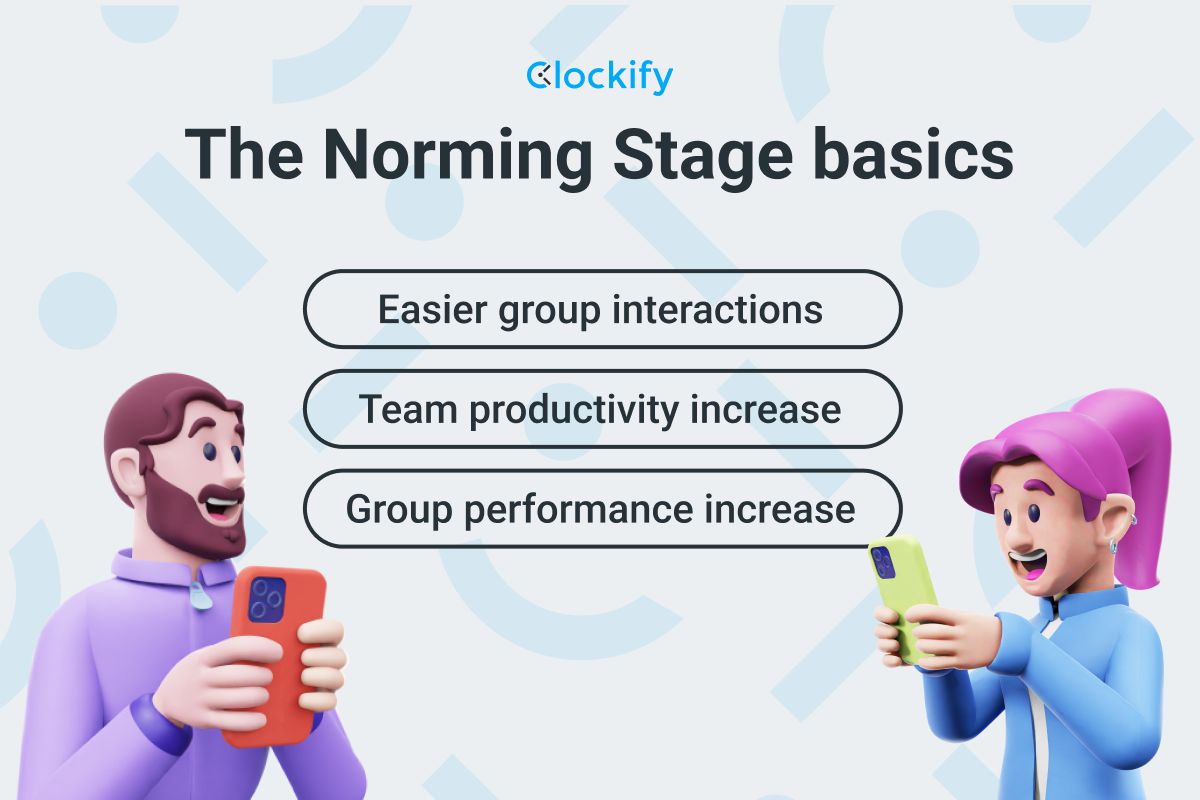
The Norming Stage brings about a sense of cooperation, integration, and unity.
Of course, you can only move on to this more pleasant stage if you’ve addressed and answered all the vital questions from the previous, Storming Stage.
The team is already used to each other’s workflows, and most future disputes and conflicts generally become easier to overcome. The official (or unofficial) team leader takes a back seat much more than in the previous stages. As a result, the individual team members are given their chance to shine.
In some cases, the Norming Stage may often be intersected by the Storming Stage. It may even revert to it unless the team makes the effort to communicate problems — and then learn from these interactions.
Here are a few signs that show your team has entered the Norming stage:
- Group interaction becomes easier,
- The team becomes more cooperative on the whole, and
- Team productivity and group performance increase.
💡 Clockify Pro Tip
To facilitate the transition from the Storming Stage to the Norming Stage, I suggest incorporating team management software into your team workflow. Here’s a list of the best tools:
Example for Stage #3 — Norming
Adam, Daisy, Daniel, and Stella are now mostly satisfied with where things are headed.
The team — no longer just a group — learns about each other’s strengths and weaknesses. More importantly, they realize how to harness their strengths and work arround their weaknesses.
Writers Adam and Daniel start to feel confident about their work and align well with Stella’s and Daisy’s guidelines for writing SEO-optimized content that resonates with their audience. In turn, the whole team is more open to:
- Feedback,
- Criticism,
- Opinions, and
- Ideas.
For example, Stella allows the rest of the team to suggest topics and angles for new articles more often.
At the same time, strict team structure diminishes.
For example, when a few typos emerge, although it’s not her job, Daisy corrects them in WordPress without accusing the writers or the editor of the mistakes.
Similar problems arise occasionally — but the way the team handles them creates an atmosphere of trust and confidence. It’s no longer a game of cat and mouse where team members try to catch each other’s errors and criticize them.
Everyone starts acting more amicably, as they are now used to each other’s work styles and points of view.
Their routine now includes a team lunch every day at 2 p.m. During one lunch on an especially productive day, everyone even gets an adorable nickname – for example, Adam becomes the Godly Scribe, and Daisy becomes their SEO Wizard.
On another occasion, Daniel invents the team’s anthem — which reflects everyone’s tendency to arrive to meetings 2 minutes after the agreed time and then apologize about it too much.
Everything seems to be going well — both with how the team members interact and what they manage to accomplish.
Boost productivity with Clockify
Overview of the Norming Stage
To provide a better summary of the behaviors, feelings, group needs, and leadership needs in the Norming Stage, check out the table below.
| Norming Stage overview | |
|---|---|
| Behaviors | – Achieving group harmony and high productivity – Assigning nicknames and creating inside jokes – Emerging of more relaxed communication – Solving problems and resolving conflicts together – Developing team routines |
| Feelings | – High level of confidence and trust – Assurance that goals will be achieved – A sense that constructive criticism is desirable |
| Group needs | – Group cohesion – Team members develop shared leadership skills – Openness to offer suggestions and ideas |
| Leadership needs | – Decline of strict structure – Promotion of intense team interaction – Strong relationships continue to build – Evaluation of productivity and processes |
Stage #4 — The Performing Stage
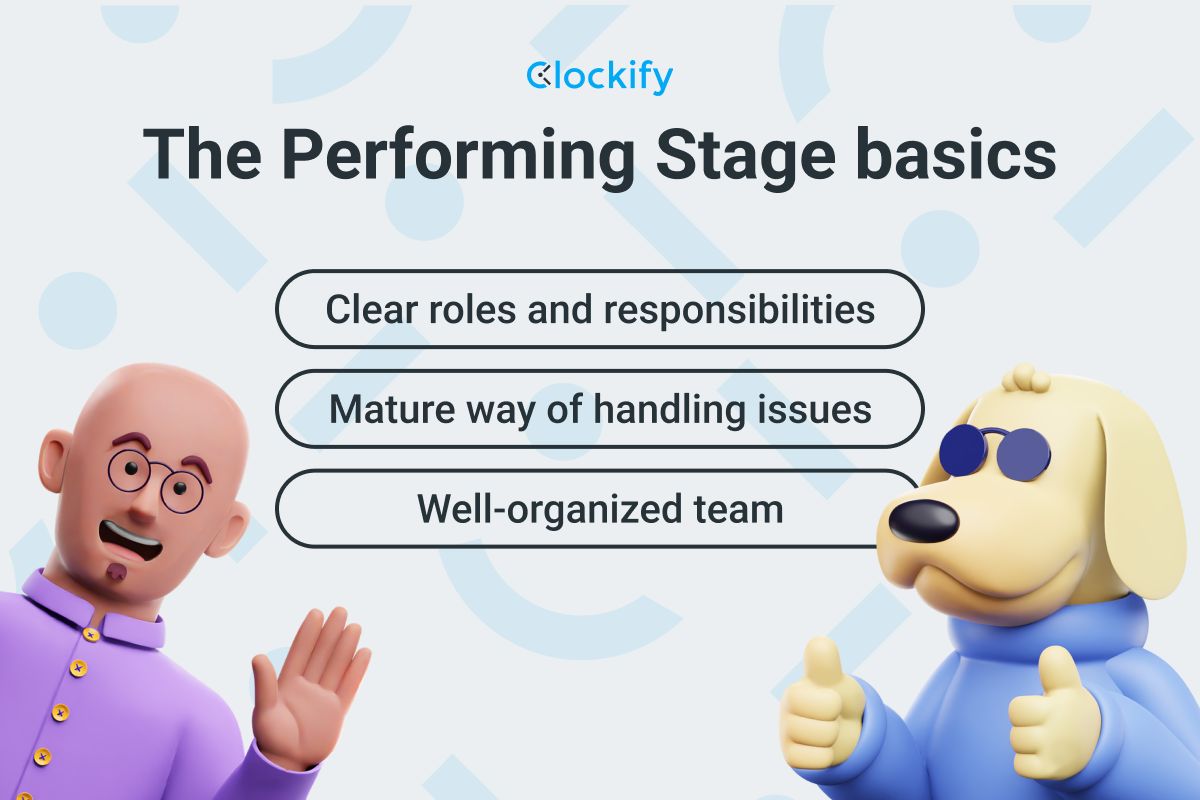
The Performing Stage is what your team is after. In this stage, you and your team get to enjoy synergy — a state where work flows smoothly.
If your team has reached this level, you’re on a clear path to success. You have a mature, well-organized group now fully focused on reaching the project goals established in the Forming Stage.
So, team members have grown fully accustomed to each other’s workflows. They respect and acknowledge each other’s skills, talents, and experience. In fact, they trust that everyone involved will do their share of the work.
Bear in mind that not all teams reach this stage. Some may falter at the earlier stages, due to the inability to properly address differences between team members or address problems as they emerge.
Here are some signs that show your team has entered the Performing Stage:
- The organization in your team is now well-established,
- The structure of roles and responsibilities is clear, and
- The team has a tested, mature, and calm way of handling issues.
To get to the bottom of things, I sat down with Brian Townsend, a former Drug Enforcement Administration agent, who was in charge of supervising and overseeing large teams. He claims that psychological safety is the number 1 marker of a group of people who make great things happen:

“A high-performing team is one where its members feel safe, can freely contribute, share opinions or concerns without judgment or fear of reprisal, can ask for help, report mistakes, and be themselves. Morale is higher, productivity is higher.”
With that said, let’s continue with our story.
Example for Stage #4 — Performing
With everything planned out, Daisy, Adam, Daniel, and Stella get to serious work.
At this stage, the 4-strong team makes things happen with plenty of empathy.
Adam and Daniel edit each other’s articles, while Stella expresses her want to learn more about SEO best practices from Daisy.
In turn, Daisy helps with content ideas. Her ideas are sometimes different from Stella’s — to everyone’s delight, as this only helps when the writers reach a creative dead end.
Work starts to flow almost seamlessly. Sure, their opinions still clash from time to time, but they appreciate each other too much to let small disagreements get in the way.
Going forward, the team expands on their inside jokes, enjoys long sessions of deep work, and creates the perfect working environment.
Everyone’s pouring their heart and soul into the content production project.
Yet, sometimes they have trouble tracking who does what — just because everybody is so involved.
At one point, Daisy, Adam, Daniel, and Stella make task tracking with an app an inseparable part of their workflow — they track the time they spend on separate tasks to see how better to organize their time on the project as they near its completion.
Finally, the team reaches the last 2 articles in the 10-piece series.
The 3-month deadline is quickly approaching.
The rest of the team gets feedback from SEO Wizard Daisy about the high performance of most articles, helping the company rank for the most relevant keywords. Everybody gets a bonus.
However, something’s not quite right, and everyone can sense it — unexpectedly, tension builds as the final stage looms large.
Overview of the Performing Stage
To make things more tangible, here’s a quick overview of the behaviors, feelings, group needs, and leadership needs in the Performing Stage.
| Performing Stage overview | |
|---|---|
| Behaviors | – Assisting one another in every scenario – Making all roles more fluid – Taking on different team responsibilities – Appreciating differences among team members – Boosting team performance to the highest level |
| Feelings | – Satisfaction – High confidence and commitment – Team culture and tight bonds – Empathy – Excitement and fun |
| Group needs | – Dialogue and feedback sessions with leaders – Assurance that collaboration is ongoing – Maintaining flexibility of processes |
| Leadership needs | – Increasing strategic awareness – Resolving conflicts positively – Delegating and overseeing by the leader – Fulfilling team members’ needs – Practicing shared leadership to the full extent |
Enhance performance with Clockify
Stage #5 — The Adjourning Stage
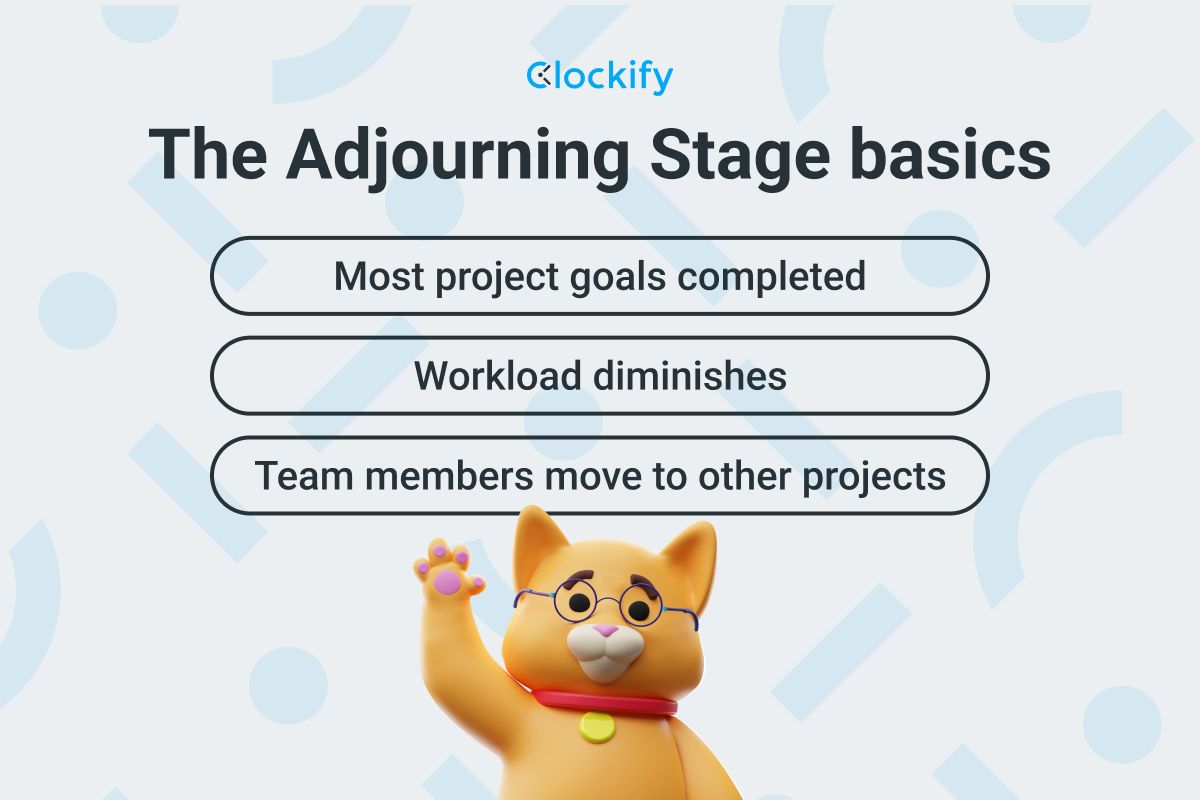
The Adjourning Stage triggers a sense of closure.
The project is completed, with most or all project goals reached.
And, it’s probably time for the team members to go their separate ways.
Now, if the team members have grown close and accustomed to working with each other, they may mourn that it’s now time to move on and work with other people.
In fact, they may even mourn the fact that the project is ending and that they need to move on to work on other projects.
The Adjourning Stage is usually associated with short-term projects, where team members are expected to disband over time. However, even “permanent” teams working on long-term projects may get gradually disbanded — as a result of a company’s organizational restructuring.
So, here are a few signs your team has entered the Adjourning stage:
- Workload slowly diminishes,
- Most of the project goals are completed,
- You’re working on leftover tasks, and
- Some team members are gradually allocated to different teams and projects.
Interestingly, a management lecturer at the University of Adelaide, Ankit Agarwal, published a 2022 paper on a phase that precedes the Forming Stage. But how does the Forming Stage relate to the Adjourning Stage?
In a nutshell, the author of the said paper argues that people often harbor negative or positive attitudes toward other group members before even a conversation has started group-wide. In fact, he asserts that the Adjourning Stage from a previous group plays an active role in the Forming Stage of a new group.
That’s why, he says, managers or team leaders must discover sources of conflict or discomfort at the outset.
With this interesting detail in mind, let’s continue our real-life example of the Adjourning Stage!
Example for Stage #5 — Adjourning
In this stage, the team feels a dip in productivity — because there isn’t much left to do.
The 3-month content project is mostly done, and everyone’s focus dissolves. They recently published all 10 articles and received praise from upper management.
With little left to do, Daisy, Adam, Daniel, and Stella decide to throw a party for good times’ sake. They’re all radiantly happy — but also feel sad that their project is ending.
They also grieve that they won’t get to see each other regularly — because they’ve grown quite close.
As luck would have it, Adam finds a senior writing job abroad, and Daisy’s manager gets her relocated to a different city. So, they both need to move on from their current office.
In the meantime, the team quickly makes a few edits that seem useful for ranking the articles even better. The project is officially completed.In the end, Stella, Adam, Daniel, and Daisy go their separate ways, capping off the project as a complete success in every way. It feels like the end of an era.
💡 Clockify Pro Tip
Learn more about how to analyze, estimate, and prepare for future projects with our guide on project management:
Overview of the Adjourning Stage
To sum up, here’s a quick overview of the behaviors, feelings, group needs, and leadership needs in the Adjourning Stage.
| Adjourning Stage overview | |
|---|---|
| Behaviors | – Increased networking – Less focus – Drop in productivity |
| Feelings | – Fluctuation of team morale – Anxiety – Grieving – Mixed feelings of satisfaction and disappointment |
| Group needs | – Recognizing team members’ vulnerabilities – Completing task deliverables – Evaluating team progress and results – Acknowledging accomplishments via festivities |
| Leadership needs | – Reflecting on tasks and goals – Transferring collaborative behavior to new tasks – Restructuring |
Why are the 5 stages of group development important?
Now, what is the importance of group development we just talked about?
Well, Tuckman’s model teaches us that teams are:
- Ever-moving and vibrant, and
- Governed by unspoken norms and a natural order of events.
At first, people are led by their natural desire to be liked by others and accepted among their peers. After all, when you have to cooperate with someone for a longer period, it’s easier to do it if you get along well — and that’s what the stages of group development get right every single time.
As time goes by, sub-groups form within a team, opinions, and personalities clash somewhat. In fact, some teams may even get stuck in the Storming Stage, unwilling to talk about their problems.
💡 Clockify Pro Tip
Get a handle on working with people with different personalities in our in-depth blog post:
But stagnation is always worse than conflict. Instead of maintaining a facade of politeness, the 5 stages of group development can help you:
- Identify your problems,
- Analyze your problems, and
- Talk about your problems.
In addition to handling conflicts, thanks to group development, you’ll need to determine workflows, follow them, and constantly tweak and improve them as you go.
As a natural consequence of it all, your project is bound to progress at a steady rate. In contrast, mismatched, uncompromising teams can only produce incomplete, confusing projects — if they produce anything at all.
Speaking of ends, the Adjourning Stage is the bittersweet cherry on top of each team and project, and it will happen whether you want it or not. It’s a great opportunity to reflect on your accomplishments and think about what you learned.
Powerful tips on how to facilitate proper group development
Now that you understand the “What?” and “Why?” behind the stages of group development, here’s the “How?”
I assembled a list of quick tips of my own and advice from experts that will help managers, leaders, and teams ensure that each stage plays out as it should.
Forming Stage tips
Let’s start from the beginning!
Here are a few powerful pieces of advice on how to approach the Forming Stage:
- Clarify the expected stages of group development right from the start. This approach helps you highlight that conflicts and problems throughout the project are normal — not a sign of failure.
- Set clear and attainable objectives for individuals, to help direct them towards their individual goals within a project.
- Establish clear and attainable objectives for the team, to help direct them towards their ultimate project goal.
In fact, the Chief Marketing Officer at SplitMetrics.com, Olga Noha, told me that navigating the 5 stages of group development can pose tremendous challenges. But she said that we should try to be open to whatever’s coming our way.

“Welcome the uncertain. It might be unsettling not to have a clear idea of how the team will evolve, but it’s equally a chance to try out diverse dynamics and roles.”
💡 Clockify Pro Tip
To learn how to best set and manage the right goals for your team, check out our previous blog posts:
Storming Stage tips
As soon as you get the basics out of the way, you are entering the Storming Stage. To help you out on this bumpy road, here are some insightful tools to handle this stage:
- Address and resolve conflicts and problems as soon as they arise.
- Coach all team members to be assertive, and stand up for their ideas and opinions in a positive and calm way.
- Provide extra support and guidance to help team members — who are less secure about voicing their opinions and ideas — stand their ground.
- Build trust among team members, by encouraging honesty, transparency, and accountability.
Since the Storming Stage can be infused with power struggles, I sat down with a leadership coach, Alexis Haselberger, to dive deeper. She told me that we must do our best to name the problems and address them properly — especially at this point, where we risk getting stuck in this stage.

“It can be very helpful to simply call out what’s happening. What stage are we in? What does that mean for us? This places the blame for any friction on the stage and not on individuals.”
Norming Stage tips
Next up, the Norming Stage can be a tricky phase as your team could slide into the previous, Storming Stage. So, tread carefully!
On that note, let’s look at a few tried and tested tips to ease your way into the Norming Stage:
- Arrange at least 1 team-building activity per week or month (or whatever works best), to help people grow closer as a team.
- Encourage off-work get-togethers to inspire group cohesion.
The former DEA agent turned team development expert, Brian Townsend, had some nuggets of wisdom to share on this point as well. He said that nothing trumps accountability:

“Everyone should be encouraged to take personal responsibility and ownership — and openly address any concerns they have. By this time, the team leader should have developed this type of safe environment. If mistakes are made, members should be encouraged to report them so solutions can be developed and everyone can benefit from lessons learned.”
💡 Clockify Pro Tip
Speaking of accountability in teams, read our all-encompassing guide on this topic:
Performing Stage tips
The most productive of all, the Performing Stage yields immense benefits for the tasks and goals you established in the first 3 stages.
In the Performing Stage, your team — well — performs at its optimum level, creating near-unshakable harmony and consistent teamwork.
Now, let’s explore a few tips to skyrocket your Performing Stage:
- Delegate tasks appropriately and in line with the skills, experience, and interests of individual team members.
- Track the time you spend on individual tasks to build daily and weekly reports of the time you spend on the project. You can then further analyze your reports to see how much time you need to finish individual project tasks and whether there is room for improvement in that time.
Surprisingly, leadership coach Alexis Haselberger told me that spending lots of time in this stage is, actually, not an issue.

”There’s no problem getting ‘stuck’ in this stage. If you’re here, that’s great!”
💡 Clockify Pro Tip
All stages of group development have their fair share of challenges, and the same applies to the Performing Stage. So, grab your chance to learn more about how to phrase and delegate assignments in our blog post:
Adjourning Stage tips
Last but not least, the Adjourning Stage — often called the Mourning Stage for obvious reasons — ends the whole project cycle. Depending on the leader of the group, the Adjourning Stage can either be a leeway into future endeavors or it could impact future collaboration.
In any case, it’s the saddest of all the 5 stages of group development.
With that in mind, here are a few time-tested tips on how to make the Mourning Stage less about mourning and more about optimism toward the future:
- Recognize and celebrate the team’s achievements to make sure your work as a team ends on a positive note. This is important considering that at least some of you may work together in the future once again.
- Share your thoughts and feelings with all team members to make sure no underlying issues remain unresolved. It’s critical to have everyone on the same page at the very end of the project.
💡 Clockify Pro Tip
To help make the transition from the Adjourning Stage to the next project’s Forming Stage painless, here are a few time management exercises you can try out:
Use Clockify to create a team of high-performers
Working in a group of people is a complex, all-consuming task that takes plenty of effort, time, and patience.
Now, you can enhance your team cohesion and elevate productivity by using a time tracking software like Clockify. Wherever you are in your group development journey, you can use Clockify to set clear time estimates for your projects.
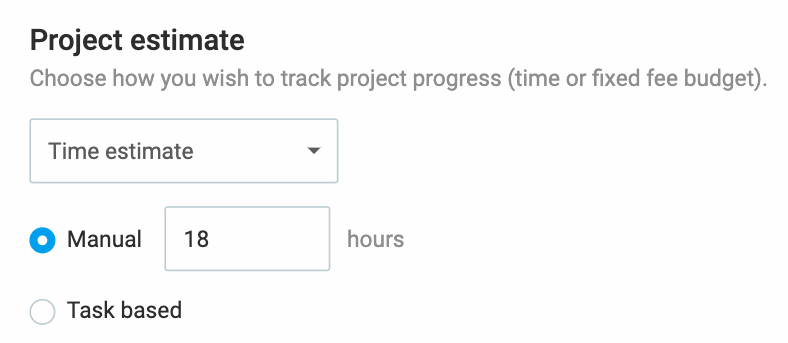
To set time estimates in Clockify, do the following:
- Check Time estimate under Project estimate in your project Settings, and
- Insert the number of hours per project manually if you have a specific number of hours in mind.
Similarly, Clockify lets you set time estimates per task if you find that more appealing rather than setting them for whole projects.
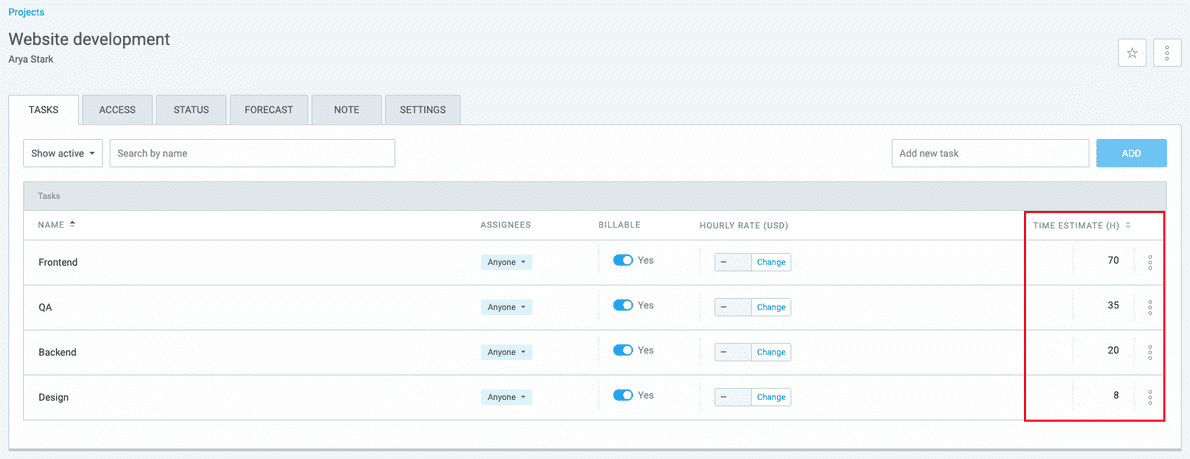
To set task-based time estimates, follow the process below:
- Visit your project,
- Click on the Tasks bar, and
- Set estimates in the Time estimate column at the far right of your screen.
With this feature in Clockify, you can set clear benchmarks for your whole team. As a result, you get a laser-focused team of high-performers who know what you expect from them.
However, Clockify offers many additional features within different plans designed to help you simplify your teams’ work. All you need to do is pick the one that’ll suit your workflow best.
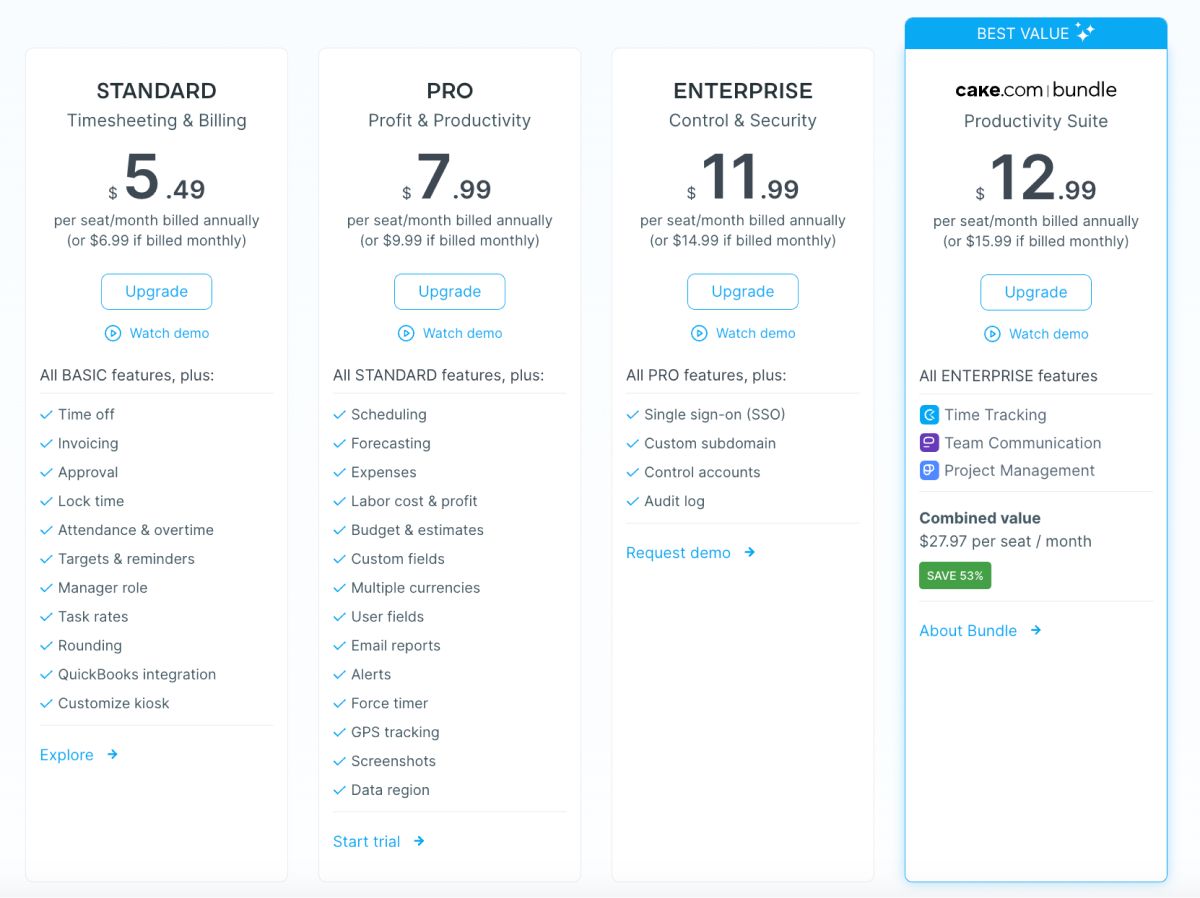
Start tracking, managing, and optimizing your work hours today.



